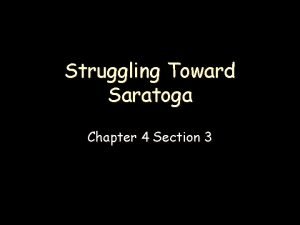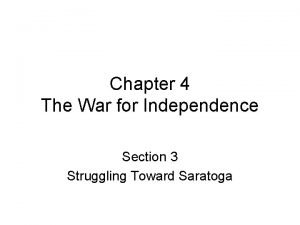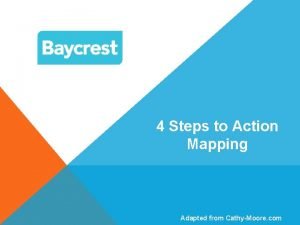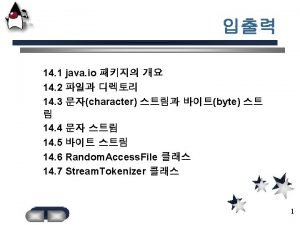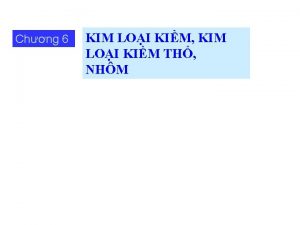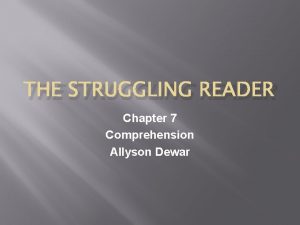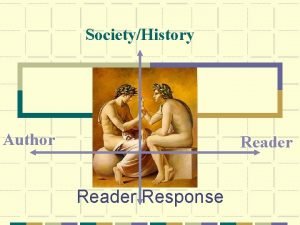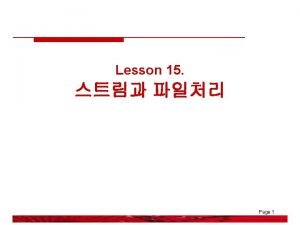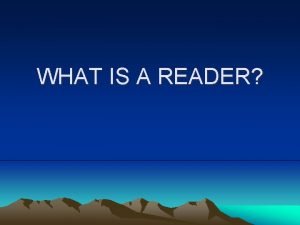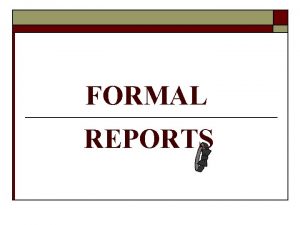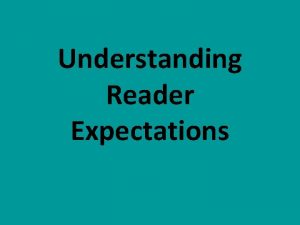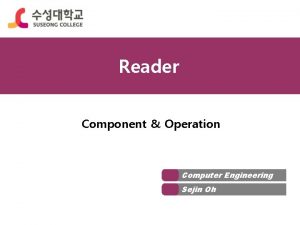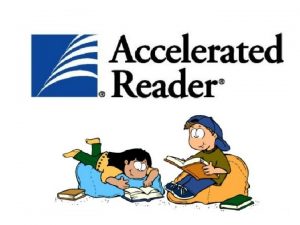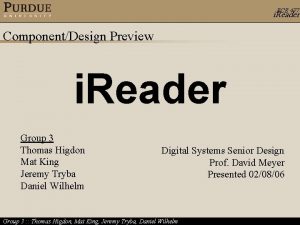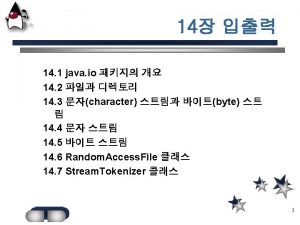Action Plan for Struggling Reader Kim Moore ED































- Slides: 31

Action Plan for Struggling Reader Kim Moore ED 546

Abstract This action plan will present and discuss the needs of a 7 year old, second grade student from Iraq. He moved to the United States in the spring of 2014 with limited English exposure. For the purpose of this action plan he will be referred to as Henry. This action plan will assess skills such as, alphabet knowledge, phoneme awareness, basic word knowledge and comprehension. From this assessment appropriate lessons will be developed and implemented. Progress monitoring and final assessment of Henry will also be documented. Keywords: action, plan, assessment, monitoring, Henry

Henry can read text within a reading level B Overview Strengths: § Despite only being in the United States for less than a year Henry can identify all letters of the alphabet. § Firm grasp of literacy knowledge; left to right, top to bottom § Open to trying new things. § Works well with peers and adults. Weaknesses: § Lack of word knowledge § Phonemic awareness § Comprehension skills which is consistent with his ability to recite and define/explain/use in a sentence some pre-primer sight words. Henry is significantly behind his grade level peers as well as his first grade sister which has caused social frustrations. His family and home living conditions frequently cause distractions during the school day. Henry’s motivation in ELL pull out class has dramatically decreased since his partner moved. I believe that refocusing and motivating him can increase his learning potential and grow his reading skills. Henry can read text with a reading level B which is consistent with his ability to recite and define/explain/use in a sentence some pre-primer sight words.

Pre-Assessment Henry was assessed using Jerry Johns’ Basic Reading Inventory the morning of November 2, 2015. This assessment took place in a classroom setting with one other instructor working with another child. It was the most optimal location free from distractions and other student learning. Based on previous observations and informal assessments such as running records and Dolch Sight Word tests I determined that Basic Reading Inventory would provide quality assessment of Henry as an emergent reader. I chose to utilize the Early Literacy Assessment of the BRI in order to address Henry’s phonemic deficiencies and comprehension struggles. In most cases you may note that Form 2 was used. This was not for any specific reason other than Form 1 would not print. Form 1 (where applicable) will be used later in a follow up assessment. Henry’s pre-assessment results are included in the Appendix.

Standards for Assessment The Basic Reading Inventory-Early Literacy use 10 tests to assess the five core components of effective reading instruction (Johns, 2012, p 8 -9). § § Phonics: Auditory Discrimination & Writing Phonemic Awareness: Phoneme Segmentation & Phoneme Awareness Fluency: Pre-Primer Passages, Caption Reading & Basic Word Knowledge Vocabulary: Wordless Picture Reading, Basic Word Knowledge & Pre. Primer Passages § Comprehension: Pre-Primer Passages & Caption Reading Note: for this purpose, pre-primer is defined as late kindergarten to beginning first grade and frustration level is defined as word errors of over 5 per 100 words of text and comprehension questions below 70 percent accuracy.

Protocol A timer, BRI scripted passages and continuum included in the record book were used to assess the following: § Fluency: As students read word lists, assess automaticity of pronunciation. Note phrasing, expression, rate or speed. § Vocabulary: Note if words are recognized by sight, how students answer questions after passage reading and expressiveness while reading. § Phonics: Note miscues and analyze them to determine areas for instruction and intervention. § Comprehension: Document questions (topic, fact, inference, experience/evaluation, and vocabulary), retelling or combination of both (Johns, 2012, p 8 -9).

Pre-Assessment Results Henry needed lots of encouragement to complete the pre-assessment. He did not particularly act in any hurry and remarked that he wasn’t bored but fidgeted through much of the test and regularly let his attention wander. He was not evaluated on literacy knowledge because he had shown that he knows where to begin and where to go while reading, capital letters, etc. Additionally, I started phoneme segmentation assessment with Henry but he did not understand it and got extremely frustration. I chose not to compound the problem and skipped that part of the test. Using a scale of 0 -10 with 10 being the highest level of success: 10. . . Student answered 100% of the questions accurately or showed evidence of complete understanding of concept. 5. . . Student answered 50% of questions correctly or showed partial understanding of concept. 0. . Student answered no questions correctly or showed no understanding of concept.

Pre-Assessment Analysis Alphabet Knowledge Auditory Discrimination § § Asked to listen to 2 words and decide if they were the same word or different. § Able to correctly identify bed/bad, look/look, get/get, fan/tan, sold/sold. § He was not successful at determining the words, moth/moss, sick/sit, tip/tick, hit/sit, pick/pin, gnat/nap. § Lack of motivation may have played a part in a 50% score. § § Knows all capital letters. Identified “q” as “p” but self-corrected. He did not know letter “g” and asked to skip it. Letter “j” was identified as “g”. In addition to correctly identifying letter names Henry also correctly identified letter sounds of many of the letters without prompting. While second graders should score 100% on alphabet knowledge I believe this to be a strong area for Henry. Confusion of “g” and “j” is probably based on his limited English and the understanding he has of “g” and “j” letter sounds.

Pre-Assessment Analysis Writing § § § Henry would lose focus, find something in the room to stare, put his hood up on his hoodie and refused to write. Took a very long time to get any work out him. Has a firm grasp on directionality in writing and can form letters and words appropriately (left to write, top to bottom). Commendable as writing in Arabic is bottom to top and right to left. Students who are older often struggle with this change where Henry seems to have grasped it. Henry, however, does struggle with letter sound relationships particularly ending and middle sounds of words.

Pre-Assessment Analysis Wordless Picture & Caption Reading § § § Sense of what was happening in the story (bird, egg, nest) but was not able to read what he had previously just dictated. Words were choppy and did not constitute complete thoughts. Henry was able to read the caption correctly for 4 pictures of cats. The cat sits, the cat walks, the cat eats and the cat sleeps. Needed to be refocused 3 times throughout the assessment. Henry was not able to 100% correctly say a word when I pointed to it out of order. For instance, if I pointed to “cat” in “the cat sleeps” Henry said sleeps and then with refocusing was able to correctly identify the word.

Pre-Assessment Analysis Phoneme Awareness, Phoneme Segmentation & Basic Word Knowledge Comprehension § Henry’s weakest areas. § Began phoneme segmentation but stopped when Henry’s frustration level became too high. § Henry did attempt the phoneme awareness section of the Jerry John’s test. He did not correctly spell any of the words read to him. § Out of the 12 words Henry received 9 correct beginning letter sounds, 3 middle and 6 ending. § Henry correctly identified 10 out of 15 basic words. The 5 incorrect were: and, with, are, that and have. • Henry’s final assessment was reading a pre-primer passage. • Took him 2 minutes and 40 seconds to read the 25 word passage. • Presented with 5 total miscues and 4 significant miscues. • Missed 3 out of the 5 comprehension questions. • Indicates this passage to be at a frustration level for Henry.

Findings The findings of the pre-assessment suggest that Henry would most benefit from lessons that target his ability to hear, identify, and manipulate individual sounds. By engaging in strategies targeted to phonemic awareness Henry should be able to improve his comprehension and spelling abilities. This should in turn increase motivation in his writing. While Henry knows his letter names and sounds, that knowledge does not translate to hearing and writing whole words. There is difficulty in connecting the sounds he knows when used in connection with other letters. Henry would benefit from reviewing all sounds again.

Strategies Categorization to teaching rhyming and initial sounds and Say It and Move It to review letter sounds and letter/word relationships. These strategies were taken from Road to the Code by Benita A. Blachman. Sound Sorts, blending and segmenting sounds to assist growth in decoding and encoding skills. Picture Card Snap, specific and repeated practice in matching initial, medial, and final sounds to pictures. Sorting, letter sounds, pictures and words to enhance phonics, vocabulary and word awareness. Information will be taken from Words Their Way by Francine Johnston, Marcia Invernizzi, Donald R. Bear and Shane Templeton.

Instructional Plan Lessons with Henry were organized using a template addressing strategies, objectives, modeling, guided practice, independent practice and reflection. Due to the nature of my time with Henry I was able to conduct more than 10 lessons but only 10 will be mentioned for the sake of this action plan. I was able to meet with Henry in 30 minute increments. His attention span is relatively short so I tried to include a variety of strategies and activities in each lesson. I was able to model the procedure for each strategy. When a new strategy was introduced I would model it about two times. The third (and subsequent) day of using the strategies we were able to go right to guided practice as Henry knew how to follow the technique or process.

Unit 1 Lesson 2 NA Procedures for Say It and Move It Rhyme cards w/clothes pins Procedures for Say It and Move It Practice /i/ vs /e/ Rhyme cards w/clothes pins Say It and Move It Categorization by rhyme Student will segment word sounds. Student will practice grouping words that rhyme. Say It and Move It Categorization by initial sound Student will segment word sounds. Student will group words by beginning sound. Guided Practice Say It and Move It (a, s, t) Categorization by rhyme (an, en, ug, et) Say It and Move It (i, p, n, ck) Categorization by rhyme (at, un, op, am) Say It and Move It (e, h, r) Categorization by initial sound p, h, c, n, j) Independent Practice Rhyme cards w/clothes pins Take home for extra practice BINGO with letters a, s, t, i, p, n, c, k, e, h, r Henry did fantastic. Totally engaged. Will adapt Say It and Move It strategy to follow all letters using the order in Jolly Phonics. Categorization by rhyme seems a little easy for Henry Struggled a little with /i/. His tendency is to say /e/. Will continue to review. Categorization by rhyme still very successful. Going to still continue with the last few cards as he generally struggles with this concept. Difficult time focusing, clearly his mind is somewhere else. Changed independent practice to BINGO game to try to get him more involved. Review Strategies Used Objectives Reflection Lesson 3 Can identify & categorize by initial sound but does not always pronounce the beginning sound correctly (/c/, /h/) § During guided practice exact procedure of Road to the Code (Blachman, Ball, Black, Tangel, 2000) was read and followed for Say It and Move It and Categorization. § Sorting of letters and pictures from Words Their Way (Johnston, Invernizzi, Bear, Templeton, 2008) was conducted by reviewing the letters for the day, contrasting them and sorting by initial sound in columns in Henry’s notebook.

Unit 1 Lesson 4 Review Strategies Used Objectives Guided Practice Independent Practice Reflection Lesson 5 /i/ vs /e/ and beginning sounds c, h Say It and Move It Categorization by initial sound /i/ vs /e/ and beginning sounds c, h Student will segment word sounds. Student will group words by beginning sound. Student will segment word sounds. Student will sort by initial word sounds. Student will identify difference in /i/ & /e/. Say It and Move It (m, d, g, o) Categorization by initial sound (m, b, d) Say It and Move It (u, l, f, b) Sort #1 (b, m, r, s) & #2 (t, g, n, p) BINGO review of all letters/sounds covered up to this point Sound sorts buckets (tiny items sorted by letter sound-bear, book, marshmallow, red, snake, etc. There were 24 items. ) Great job all around today! Will review i/e/c/h one more time and if he does well will revisit after assessment. Enjoyed using new strategies today. Don’t see a need to review i, e, c, h at this time. Say It and Move It Sorting Lessons typically followed the following format: § Review 3 -5 minutes § Say It and Move It 5 -7 minutes § Categorization 5 -7 minutes § Sorting 10 minutes § Picture Card Snap 10 minutes § Writing 5 minutes Not all strategies were used every day. Lessons generally stayed around 30 minutes.

Progress Monitoring Unit 1 Dibels 6 th Edition Initial Sound Fluency & Dibels 6 th Edition Phoneme Segmentation Fluency § Correctly identified 13 out of 16 initial sounds in 74 seconds for a correct initial sounds pre minute score of 10. 5. § Not able to identify the pictures representing /l/, /sl/, /oa/. § Error pattern of diagraphs, blends and long i patterns. § Did correctly segment 5 out of 20 ending sounds (of those not associated with blends). § Additionally, the only initial sound Henry was not able to identify was /w/. Imagine Learning § § § Computer program that teaches and assesses students in literacy. Students receive placement based on current literacy and language abilities. They then are assigned appropriate content. Students are constantly evaluated to determine what type of instruction they’ll receive and how much support they need. Teachers are provided detailed reporting, including data on student progress and skills students have mastered. Results showed deficiencies in CVC words with /a/, /e/ & /i/ sounds. Word family struggles on -ed & -in.

Dibels 6 th Edition Progress Monitoring Unit 1

Unit 2 Review Strategies Used Objectives Guided Practice Independent Practice Reflection Lesson 6 Quickly review & wrap up all Say It and Move It Lesson 7 Picture Card Snap procedures Say It and Move It Sorting Picture Card Snap Student will segment word sounds. Student will sort by initial word sound. Student will recognize similar initial word sound patterns. Say It and Move It (j, z, w, v) Sort #3 (c, h, f, d) & #4 (l, k, j, w) Picture Card Snap (initial sounds-s, t, p, g) Sorting Picture Card Snap Sorting worksheet plus extra sheet for home practice Make and read -at family word book. Take home for extra practice. Henry enjoyed Picture Card Snap. Very competitive! I’m just happy he was focused and alert. Having fun with Picture Card Snap. Will try to spend more time on that strategy since he enjoys it. Lesson 8 Revisit g, j Read -at family word book Sorting Picture Card Snap Student will sort by initial word sound at family. Student will recognize similar initial word sound patterns. Student will sort by -ap and -ag. Student will recognize similar final word sound patterns. Sort #5 (q, y, v, z) & #6 (at family w/ words) Picture Card Snap (initial sounds-n, j, r, h) Sort #7 (-an and -ad family w/words & pictures) & #8 (-ap and ag family w/words & pictures) Picture Card Snap (ending sounds-m, l, b) Make and read -an and ad family word book. Take home for extra practice. Spent extra time with Henry today because he wanted to write! Couldn’t pass up that opportunity. I just let him go for it. (See figure 6) Note: Activities to do after school were sent home with Henry to practice. Where applicable, activities were reviewed before the start of the day’s lesson.

Unit 2 Review Strategies Used Objectives Guided Practice Independent Practice Reflection Lesson 9 Read -an & -ad family word book. Sorting Picture Card Snap Student will sort by –op, -ot and -og. Student will recognize similar medial word sound patterns. Sort #9 (-op, -ot and -og family w/words & pictures) & #10 (-et, eg and -en family w/words & pictures) Picture Card Snap (medial sounds-a, e, i) Make and read -op and -ot family word book. Not focused. Looked like he wanted to fall asleep. Said he wasn’t able to sleep much last night. Hopefully he’ll read his -op and -ot family word book at home. Lesson 10 More work on medial sounds /e/, /i/! Read -op and -ot family word book Sorting Picture Card Snap Student will sort by -ug, -ut, -un, -ip, -it, and -ill. Student will recognize similar medial word sound patterns. Sort #11 (-ug, -ut and -un family w/words & pictures) & #12 (-ip, -it and -ill family w/words & pictures) (Figure 7) Picture Card Snap (medial sounds-o, u) Make and read -ug, -un and -ill family word book Overall, given his home distractions, Henry seemed to do well learning with new strategies. Will continue Picture Card Snap using initial, medial, ending sounds. Henry would benefit from more instruction/practice on medial sounds /e/ & /i/ Word Family Sample Reading Homework

Tools Sound Sorts Writing Family Word/Picture Sort Picture Card Snap, sample

Progress Monitoring Unit 2 Dibels 6 th Edition Initial Sound Fluency, Phoneme Segmentation Fluency Imagine Learning § Did not show any growth in initial sound fluency. § Henry missed more initial sounds than progress monitoring #1 § Was not able to identify /ea/, /m/, /h/ and /b/. § Correct initial sounds per minute score was 9. 11. § Deficiency in diagraphs and blends. § Initial and final sound segments are strong § Indicated that Henry needs more practice on word family -amp and -ick as well as § Short e word work(such as bell, jet, nest) § Segmenting initial phoneme sound /j/

Dibels 6 th Edition Progress Monitoring Unit 2

Post Assessment Results • Using a scale of 0 -10 with 10 being the highest level of success: • • 10. . . Student answered 100% of the questions accurately or showed evidence of complete understanding of concept. • • 5. . . Student answered 50% of questions correctly or showed partial understanding of concept. • • 0. . Student answered no questions correctly or showed no understanding of concept.

Post Assessment Analysis Alphabet Knowledge & Writing Basic Word Knowledge § Scored high on alphabet knowledge missing the letter J (substituting G) on both capital and lower case. § Henry will say what he wants to write, draw the line spaces for it and then attempt to sound out his words. § He is showing progress on initial and final sounds. § Identified 13 out of 15 words correctly. § Substituted “do” for “they” and “hat” for “he”.

Post Assessment Analysis Wordless Picture & Caption Reading § § § Very entertained by the wordless picture reading story on form 1. Had a general sense of what was happening in the pictures between the dog and squirrel (and identified both as such) Did not fully grasp the role of the squirrel in the pictures remarking that the squirrel was hiding his food with the dog’s. Henry’s caption reading closely matched the text. When asked to repeat words at random he was able to do so. Did not attempt the word walk and did not use the ending ‘s’ on any but 1 word in the text. Auditory Discrimination § Improved by 25% correctly identifying 9 out of 12 words to the 6 out of 12 during the preassessment. § Failed to identify buff/bus, set/sit, foam/phone.

Post Assessment Analysis Phonemic Awareness (Spelling) Phonemic Segmentation § Correctly spelled (phonemic awareness) 0 out of 12 words. § Beginning sound identification was 10/12, middle 3/12 and ending 6/12. § Results are basically the same as his pre-assessment with beginning sound increasing by one. § Successfully segment 10 out of 11 words. § Recognized the word “red” to have 3 sounds but identified them as r/a/d Comprehension § In the passage “Kim’s Dog”, Henry had 1 total miscue and 0 significant miscues making this passage at an independent/instructional level. § Read the 20 words in 1 minute and 42 seconds. § Henry correctly answered 4 out of 5 follow up comprehension questions.

Skills Assessed Growth Model Evidence of skill

Conclusion § Henry has shown significant growth in the areas of phonemic segmentation and comprehension. § He would continue to benefit from strategies aimed at segmenting with concentration on medial sounds. § Writing exercises everyday. § Word study program to grow vocabulary leading to increased comprehension.

Appendix Pre-Assessment Data Post Assessment Data Complete data can be viewed at: https: //literacyatoz. files. wordpr ess. com/2015/12/preassessment-action-planstudent. pdf Complete data can be viewed at: https: //literacyatoz. files. wordpr ess. com/2015/12/postassessment 12102015. pdf

References Blachman, B. A. , Ball, E. W. , Black, R. and Tangel, D. M. (2000). Road to the code: a phonological awareness program for young children. Baltimore, MD: Paul H. Brookes Publishing Co. Johns, J. L. (2012). Basic reading inventory. Dubuque, IA: Kendall Hunt Publishing Company. Johnston, F. , Invernizzi, M. , Bear, D. R. , Templeton, S. (2008). Words their way: word sorts for letter name-alphabetic spellers. Upper Saddle River, N. J: Merrill.
 Struggling toward saratoga section 3
Struggling toward saratoga section 3 Struggling in silence
Struggling in silence Remediation of the struggling medical learner
Remediation of the struggling medical learner Chapter 4 section 3 struggling toward saratoga
Chapter 4 section 3 struggling toward saratoga The outsiders adapted for struggling readers
The outsiders adapted for struggling readers Cathy moore action mapping
Cathy moore action mapping Fspos
Fspos Typiska drag för en novell
Typiska drag för en novell Nationell inriktning för artificiell intelligens
Nationell inriktning för artificiell intelligens Ekologiskt fotavtryck
Ekologiskt fotavtryck Varför kallas perioden 1918-1939 för mellankrigstiden
Varför kallas perioden 1918-1939 för mellankrigstiden En lathund för arbete med kontinuitetshantering
En lathund för arbete med kontinuitetshantering Personalliggare bygg undantag
Personalliggare bygg undantag Tidbok
Tidbok A gastrica
A gastrica Förklara densitet för barn
Förklara densitet för barn Datorkunskap för nybörjare
Datorkunskap för nybörjare Tack för att ni lyssnade bild
Tack för att ni lyssnade bild Hur skriver man en tes
Hur skriver man en tes För och nackdelar med firo
För och nackdelar med firo Nyckelkompetenser för livslångt lärande
Nyckelkompetenser för livslångt lärande Påbyggnader för flakfordon
Påbyggnader för flakfordon Formel för lufttryck
Formel för lufttryck Svenskt ramverk för digital samverkan
Svenskt ramverk för digital samverkan Kyssande vind
Kyssande vind Presentera för publik crossboss
Presentera för publik crossboss Argument för teckenspråk som minoritetsspråk
Argument för teckenspråk som minoritetsspråk Vem räknas som jude
Vem räknas som jude Klassificeringsstruktur för kommunala verksamheter
Klassificeringsstruktur för kommunala verksamheter Epiteltyper
Epiteltyper Bästa kameran för astrofoto
Bästa kameran för astrofoto Cks
Cks
